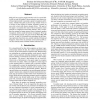Free Online Productivity Tools
i2Speak
i2Symbol
i2OCR
iTex2Img
iWeb2Print
iWeb2Shot
i2Type
iPdf2Split
iPdf2Merge
i2Bopomofo
i2Arabic
i2Style
i2Image
i2PDF
iLatex2Rtf
Sci2ools
INTERSPEECH
2010
2010
Approaching human listener accuracy with modern speaker verification
Being able to recognize people from their voice is a natural ability that we take for granted. Recent advances have shown significant improvement in automatic speaker recognition performance. Besides being able to process large amount of data in a fraction of time required by human, automatic systems are now able to deal with diverse channel effects. The goal of this paper is to examine how state-of-the-art automatic system performs in comparison with human listeners, and to investigate the strategy for human-assisted form of automatic speaker recognition, which is useful in forensic investigation. We set up an experimental protocol using data from the NIST SRE 2008 core set. A total of 36 listeners have participated in the listening experiments from three sites, namely Australia, Finland and Singapore. State-of-the-art automatic system achieved 20% error rate, whereas fusion of human listeners achieved 22%.
Automatic Speaker Recognition | Human Listeners | INTERSPEECH 2010 | Signal Processing | Speaker Recognition Performance |
| Added | 18 May 2011 |
| Updated | 18 May 2011 |
| Type | Journal |
| Year | 2010 |
| Where | INTERSPEECH |
| Authors | Ville Hautamäki, Tomi Kinnunen, Mohaddeseh Nosratighods, Kong-Aik Lee, Bin Ma, Haizhou Li |
Comments (0)

